The Hill-Tribes
Saturday 20 November 1999 – Wednesday 24 November
1999
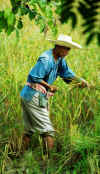 After three days relaxing in a
country retreat, we once again headed for the airport to pick up a flight to Nan
in the far northeastern part of the country. One of Thailand’s most remote provinces, there was little
here before the 1980's, when bandits and insurgents were still rife.
In the last two decades, however, Nan has opened up and roads are being
built to provide more access. It is
largely a rural province with not a factory or condo in sight, and is situated
right across the border from Xayabury province in Laos, similarly covered by
heavily-forested mountains.
After three days relaxing in a
country retreat, we once again headed for the airport to pick up a flight to Nan
in the far northeastern part of the country. One of Thailand’s most remote provinces, there was little
here before the 1980's, when bandits and insurgents were still rife.
In the last two decades, however, Nan has opened up and roads are being
built to provide more access. It is
largely a rural province with not a factory or condo in sight, and is situated
right across the border from Xayabury province in Laos, similarly covered by
heavily-forested mountains.
Nan is a sparsely populated
province with distinct ethnic groups. The two groups we were most keen
to learn more about were the Hmong and Mabri.
Having first heard about both during our time in Laos, we had started to
read up on each of the two tribes and learn more about their customs and
culture.
Hmong form a large
contingent of the hill-tribe population in both Laos and Thailand, and are
probably the most well-known hill-tribe internationally given the
large proportion who fled from Laos after the 1975 revolution and were
repatriated in the US, Canada, France and Australia.
They have a very strong and distinctive culture which we were intrigued
to learn more about.
The Mabri are referred to by
Thais as 'spirits of the yellow leaves', because they customarily move on
when the leaves of their makeshift huts turn yellow.
They
are the most nomadic and most endangered of all the minorities in Laos or
Thailand, numbering only a few hundred. In the past they were strict hunter-gatherers, living off
what they could find in the jungle, but many are now semi-nomadic, working from
time-to-time as field laborers for other
hill tribe groups such as Hmong in exchange for pig fat or vegetables.
Little is known about the tribe’s belief system except that
they are animists who believe they are not entitled to cultivate the land for
themselves.
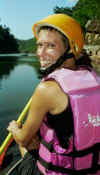 As soon as we arrived in Nan, we
enquired about finding a guide to take us into the mountains to do some trekking
and hopefully visit some of the Hmong and Mabri.
With a day to kill before we set off, we decided to try out some white-water rafting and having met up with a German doctor, Andre, set
As soon as we arrived in Nan, we
enquired about finding a guide to take us into the mountains to do some trekking
and hopefully visit some of the Hmong and Mabri.
With a day to kill before we set off, we decided to try out some white-water rafting and having met up with a German doctor, Andre, set
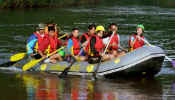 off the next
morning not quite sure what to expect. Our
safety briefing comprised of three flash cards, pointed out by our instructor
whose English was limited to say the least.
Having done it before, Eric kept telling us “all you need to remember
if you capsize, is to let go of the boat and head downstream, feet first”; great
advice if you can remember it in the panic of falling into the raging torrent.
But equipped with that advice, together with helmets and lifejackets, we
set off for what actually proved to be a fun day out.
The river wound its way through a small valley with sheer rock faces in
parts and lush forest vegetation all around.
The first part was easy: relatively calm waters on which to practice
our
off the next
morning not quite sure what to expect. Our
safety briefing comprised of three flash cards, pointed out by our instructor
whose English was limited to say the least.
Having done it before, Eric kept telling us “all you need to remember
if you capsize, is to let go of the boat and head downstream, feet first”; great
advice if you can remember it in the panic of falling into the raging torrent.
But equipped with that advice, together with helmets and lifejackets, we
set off for what actually proved to be a fun day out.
The river wound its way through a small valley with sheer rock faces in
parts and lush forest vegetation all around.
The first part was easy: relatively calm waters on which to practice
our 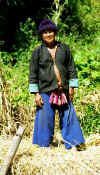 strokes and bright blue skies; but after stopping for lunch at an army camp,
we were into the rough stuff. Needless
to say, we all survived and not a single capsizing (much to Pippa’s
disappointment!) but it was great to
strokes and bright blue skies; but after stopping for lunch at an army camp,
we were into the rough stuff. Needless
to say, we all survived and not a single capsizing (much to Pippa’s
disappointment!) but it was great to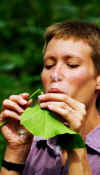 be outdoors and enjoying the open air.
be outdoors and enjoying the open air.
The next day, armed only with a
change of underwear and some mosquito repellent, we set off on our jungle
adventure. Our first mode of
transportation was a jeep but before too long, we were on our feet.
We passed through a number of different ethnic villages, but were heading
further into the mountains where we would spend two nights in one of the most
remote Hmong villages. Our guide
taught us some great tricks en route which enthralled Pippa for hours: jungle
whistles, jungle bubbles and much, much more.
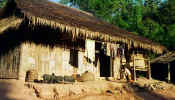 We arrived into the village by
early evening and were welcomed by some of the villagers into their home.
Our bed for the two nights was a rattan mat on wooden floorboards,
but it felt positively palatial. Given
the limited access they had to electricity, we were in bed early that night and
thank goodness … cockerel wake-up calls came early and were persistent.
Before breakfast we took a stroll around the village, watching the
children play with their spinning tops and seeing village life unfolding.
People were friendly if somewhat wary.
We arrived into the village by
early evening and were welcomed by some of the villagers into their home.
Our bed for the two nights was a rattan mat on wooden floorboards,
but it felt positively palatial. Given
the limited access they had to electricity, we were in bed early that night and
thank goodness … cockerel wake-up calls came early and were persistent.
Before breakfast we took a stroll around the village, watching the
children play with their spinning tops and seeing village life unfolding.
People were friendly if somewhat wary.
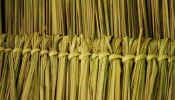
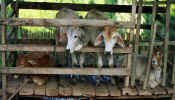
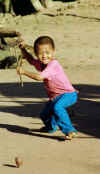
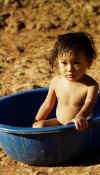
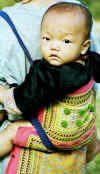
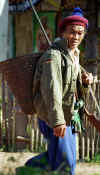
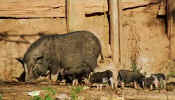
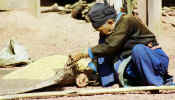
That day we planned to
head out into the jungle to see if we could find any Mabri camps.
Equipped with a bag of pig fat 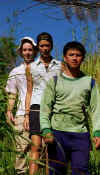 as a gift, we knew that some Mabri had
been working in one of the villagers’ fields the previous day but had no idea
if they would still be in the area. These people, as we were to discover, are true forest dwellers; the men wear very little clothing of any description, while the women
usually wear cast offs from other hill tribes or lowlanders. They have an enormous knowledge of medicinal plants, using
herbs for everything from fertility and contraception to snake or centipede
poisoning. They guard this
knowledge jealously, however, and even the Hmong and other hill-tribes with
which they come
into contact know little about their culture.
Our guide could tell us that Mabri women
typically change mates every five to six years, taking any children from her
previous union with her, and also that when a member of the tribe dies, the body is
put in a tree top to be eaten by birds.
as a gift, we knew that some Mabri had
been working in one of the villagers’ fields the previous day but had no idea
if they would still be in the area. These people, as we were to discover, are true forest dwellers; the men wear very little clothing of any description, while the women
usually wear cast offs from other hill tribes or lowlanders. They have an enormous knowledge of medicinal plants, using
herbs for everything from fertility and contraception to snake or centipede
poisoning. They guard this
knowledge jealously, however, and even the Hmong and other hill-tribes with
which they come
into contact know little about their culture.
Our guide could tell us that Mabri women
typically change mates every five to six years, taking any children from her
previous union with her, and also that when a member of the tribe dies, the body is
put in a tree top to be eaten by birds.
Fortunately, our guide did
manage to track down a Mabri couple and their two small children.
Actually, we strongly suspected luck had nothing to do with it: it is
generally conceded that no one can find a Mabri who doesn't want to be found,
and they seemed nonplussed by our arrival. Probably they had an
arrangement with the Hmong: you bring me pig fat tomorrow, I sit still for
tourists.
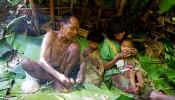 In
any event, we were thrilled: the Mabri are nomads, and their material
culture is straight
In
any event, we were thrilled: the Mabri are nomads, and their material
culture is straight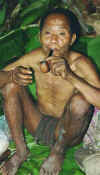 from the stone-age. This is how our ancestors are thought to have lived
for 99.9% of human evolution, yet to meet them on the eve of the 21st century
was probably a once-in-a-lifetime experience. Sitting on a hastily woven
mat underneath a stick and leave lean-to, dirty and practically naked, with no
possession in sight, the Mabri seemed not just from another time, but another
planet. Communication was extremely limited, but sign language and gestures go a long way
in such situations; Eric invited the man to share his pipe while we
watched them cooking their pig fat inside a length of bamboo.
After a time and a few photos, their patience exhausted, they asked the guide to
please take us away.
from the stone-age. This is how our ancestors are thought to have lived
for 99.9% of human evolution, yet to meet them on the eve of the 21st century
was probably a once-in-a-lifetime experience. Sitting on a hastily woven
mat underneath a stick and leave lean-to, dirty and practically naked, with no
possession in sight, the Mabri seemed not just from another time, but another
planet. Communication was extremely limited, but sign language and gestures go a long way
in such situations; Eric invited the man to share his pipe while we
watched them cooking their pig fat inside a length of bamboo.
After a time and a few photos, their patience exhausted, they asked the guide to
please take us away.
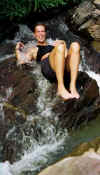 On our way back to the village,
we stopped to cool off in a small waterfall and reflected on what an amazing way
of life the Mabri lead. Basic and spartan, certainly, but the life they chose to lead. We hoped they
would not lose it in the new millennium.
On our way back to the village,
we stopped to cool off in a small waterfall and reflected on what an amazing way
of life the Mabri lead. Basic and spartan, certainly, but the life they chose to lead. We hoped they
would not lose it in the new millennium.
Back in the Hmong village, it
seems we had broken
the ice and were invited to a wedding celebration that was taking place in a
nearby home. It was unforgettable: the food was terrible, the
rice-moonshine flowed freely, the laughter was contagious, and we had a great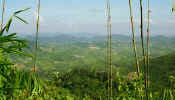 time. After yet another early morning
wake up call, courtesy of the local cockerels, we set off on foot once again to
make our way back to Nan. We
stopped for lunch, watching whilst our guide whittled three pairs of chopsticks
from a strip of bamboo, and saw at first hand some of the damage
illegal logging is doing to these hidden forests.
The scenery was spectacular, and it was once again a delight to be enjoying life
out in the open.
time. After yet another early morning
wake up call, courtesy of the local cockerels, we set off on foot once again to
make our way back to Nan. We
stopped for lunch, watching whilst our guide whittled three pairs of chopsticks
from a strip of bamboo, and saw at first hand some of the damage
illegal logging is doing to these hidden forests.
The scenery was spectacular, and it was once again a delight to be enjoying life
out in the open.